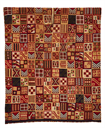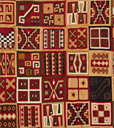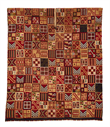Description
This tapestry tunic is one of the finest known Inka royal textiles. Typical of Inca tunics, it was woven as one long rectangle of cloth with a neck slit in the middle and then folded in half and the sides sewn up to the arm holes. It has warps of undyed cotton and wefts of dyed camelid fiber spun so fine and woven so tight that they number between 98 and 108 per centimeter. Textiles were valued more highly than gold in the Inka Empire, and much effort went into their production. Fine qompi cloth was the task of specialists, and the best cloth, used for royal and religious functions, was made by cloistered women known as acllacuna.
Unlike other Inka tunics, this one is almost entirely covered with small rectangular geometric units called t’oqapu. Created in a variety of patterns and colors, t’oqapu may have held special meaning or significance. A common t’oqapu design, depicted here in alternating red and yellow, consists of a diagonal bar between two dots. Another is a miniature representation of a black-and-white checkerboard tunic with a red collar. Scholars suggest that individual t’oqapu may have represented specific peoples, places, or things, thus constituting a sign system akin to the knotted khipu cords that the Inkas used to record information. Garments bearing this design could thus communicate the status of their wearer and possibly other information as well. We know from historical sources that only persons of high rank were entitled to wear tunics decorated with t’oqapu, and most such tunics include only a limited number of them, clustered around the neck or waist of the garment. No other known tunic incorporates such a large number and variety of t’oqapu into its design. Possibly worn by the ruler himself, this all-t’oqapu tunic broadcast the message that he controlled enormous diversity and almost the totality of possible motifs in his clothing.
Exhibition History
"Ancient Art of the Andes", Museum of Modern Art, New York, NY, 1/26 - 3/21/1954; Minneapolis Institute of Art, Minneapolis, MN, 4/21 - 6/13/1954; California Palace of the Legion of Honor, San Francisco, CA, 7/23 - 9/19/1954.
"Indigenous Art of the Americas", National Gallery of Art, Washington DC, 1954-62.
"Peruvian Spanish-Colonial Textiles", The Textile Museum, Washington DC, 3/13 - 6/1/1961(catalogue # 4).
(photo only) "The Arts of Latin America", UNESCO traveling photographic exhibition, Paris, France, 1977.cat. no. 135.
"Circa 1492: Art in the Age of Exploration", National Gallery of Art, Washington DC, 12/12/1991 - 2/12/1992.
"Machu Picchu: Unveiling the Mystery of the Incas", Peabody Museum of Natural History, New Haven, CT, 1/22 - 5/15/2003.
"The Colonial Andes: Tapestries and Silverwork 1530-1830", Metropolitan Museum of Art, New York, NY, 9/29 - 12/12/2004 (catalogue # 181).
"The Arts in Latin America 1492-1820", Los Angeles County Museum of Art, Los Angeles, CA, 8/5 - 10/28/2007.
“The Great Inka Road: Engineering an Empire”, National Museum of the American Indian, Washington DC, 6/26 – 12/4/2015.
"Golden Kingdoms: Luxury and Legacy in the Ancient Americas", The J. Paul Getty Museum, Los Angeles CA, 9/16/2017 - 1/28/2018; The Metropolitan Museum of Art, New York NY, 2/27 - 5/28/2018.
Acquisition History
Acquired by Robert Woods Bliss on June 14, 1949.
Robert Woods Bliss Collection of Pre-Columbian Art, Washington, DC, 1949-1962.
Dumbarton Oaks Research Library and Collection, Pre-Columbian Collection, Washington, DC.








